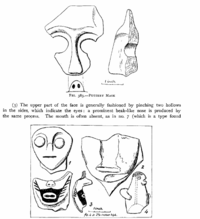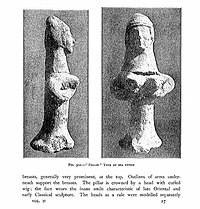Judean pillar figures or figurines were ubiquitous household items in the Iron Age representing the Canaanite great goddess Asherah.





Details edit
Scholarly consensus has categorized the figurines as the Canaanite great goddess Asherah.[2] Dissenting from this view, Erin Darby suggests other possible identifications.[3] They show her with some facial detail, protruding breasts, and completely plain cylindrical bodies below. Surely popular, they were often handmade and sometimes crude, but that led to a diversity of style. It also allowed them currency over a longer period of time, unlike the more sophisticated but then-late Revadim Asherah whose examples were mass-produced in the productive milieu leading up to the Bronze collapse.
Pillar figures are first found in small numbers around Judah in the 10th century BCE, then grew somewhat in geographic distribution and greatly in attestation. A single archaeological site could reveal them in the hundreds like in Jerusalem, or over a thousand like in Kuntillet Ajrud, so museums and universities contain a great number.
The head and cylinder body are usually separate pieces with a pin. They usually have almond-shaped eyes and a slightly twisted "teardrop" curl hairstyle, sometimes with a pinched-nose or bird-headed appearance, sometimes with clues of paint. Megiddo and Lachish had the less common examples from molds; i.e. mass-produced. "The hollow bodied figurines... appear to be typically Philistine."[4]
It's likely they were dressed. Some show hermaphroditic or androgynous character.[5] Five "male" JPFs are mentioned in Kletter.
Scholarship edit
The first cataloging attempt by Pilz included less than a dozen JPF examples and little analysis. The figures were originally half of a broad classification under two categories of goddess image: JPFs that stand on a pole-like base and plaque figures that lie. (That is, they cannot be "in the round".) Then came the discovery and gradual publication depictions of Revadim Asherah from the 13th century.
The plaque figures in Syria-Palestine are familiar to an earlier-still Egyptian tradition. The supine goddesses, more like portraits to view than dolls to hold, are made in gold by artisans for the wealthiest from Egypt and the early northern Steppes to later Achaemenid primacy. For plaques see Negbi 1976 and Budin 2016.
The first major work was theologian Kletter's in 1995. A Ron Tappy's take on it was rather excoriating, showing that Asherah-related controversy is still able to divide peers in the academy today.[6]
See also edit
Bibliography edit
- Beaulieu, Stéphane (2007-01-01). "Eve's Ritual: the Judahite Sacred Marriage Rite". Concordia University. Retrieved 2023-12-14.
- Darby, Erin (2018). "Judean Pillar Figurines (JPFs)". In Farber, Zev I.; Wright, Jacob L. (eds.). Archaeology and History of Eighth-century Judah (PDF). SBL Press. ISBN 978-0-88414-347-5.
References edit
- ^ "The Excavation Of Gezer 1902 1905 And 1907 1909. Volume II : Macalister, Robert Alexander Stewart : Free Download, Borrow, and Streaming : Internet Archive". Internet Archive. 2023-03-25. Retrieved 2024-02-13.
- ^ Darby 2018, p. 405.
- ^ Darby 2018, pp. 406–407, 410.
- ^ Beaulieu 2007, p. 303.
- ^ Sugimoto, David (2014-10-01). "Transformation of a Goddess: Ishtar". Internet Archive. Retrieved 2023-12-16.
- ^ Tappy, Ron (1998). "Review: The Judean Pillar-Figurines and the Archaeology of Asherah Raz Kletter". Bulletin of the American Schools of Oriental Research (310). American Schools of Oriental Research: 85–89. ISSN 2161-8062. JSTOR 1357582. Retrieved 2023-12-26.
External links edit
- Pillar figurine on the website of the Israel Antiquities Authority
- Media related to Pillar figurines at Wikimedia Commons
This article needs additional or more specific categories. (December 2023) |